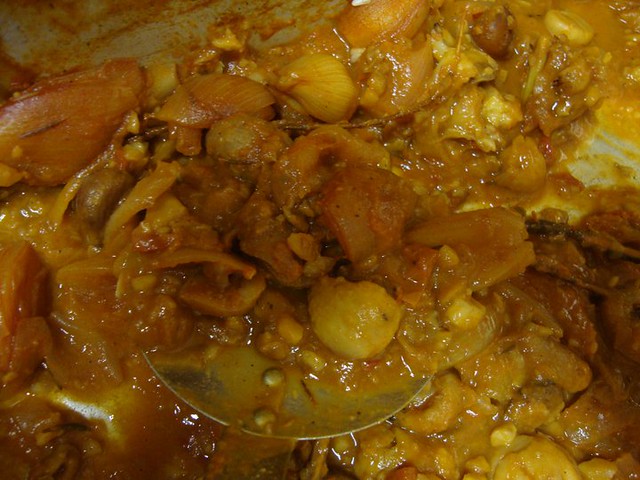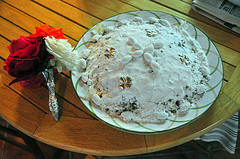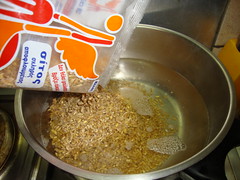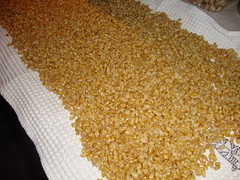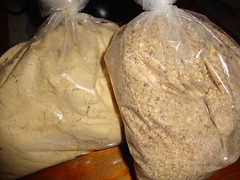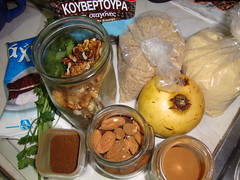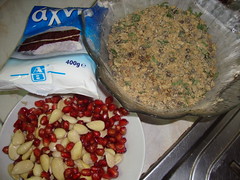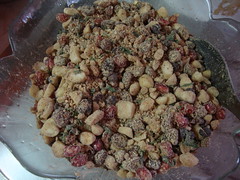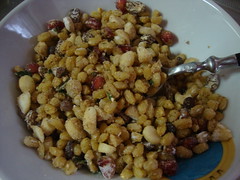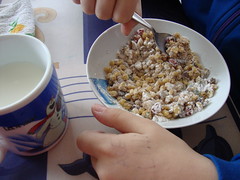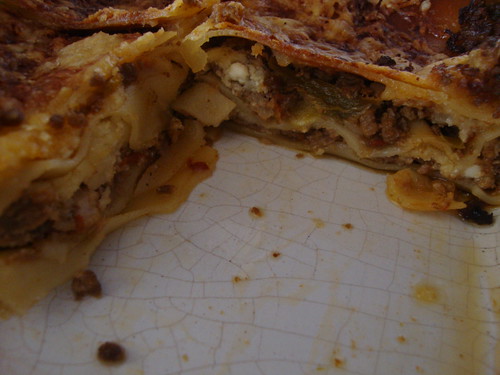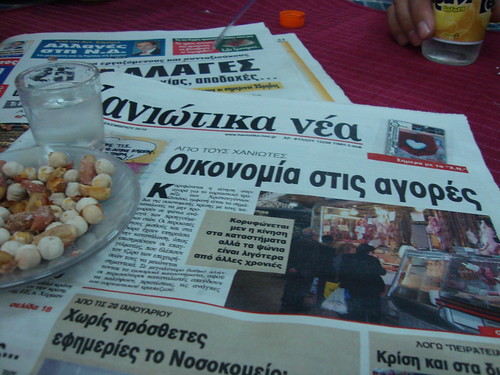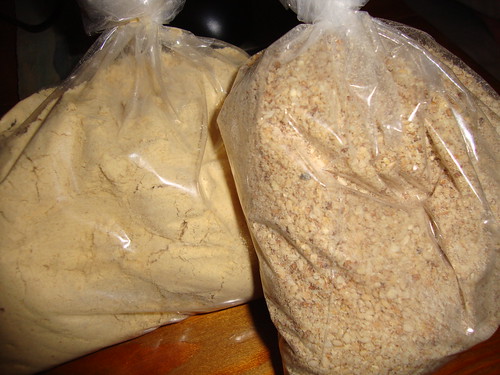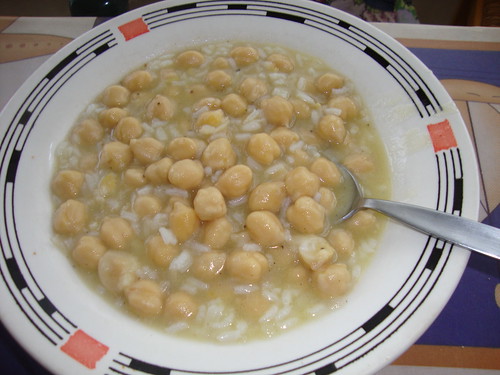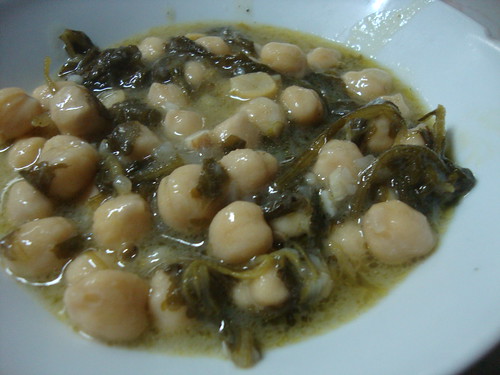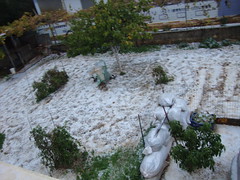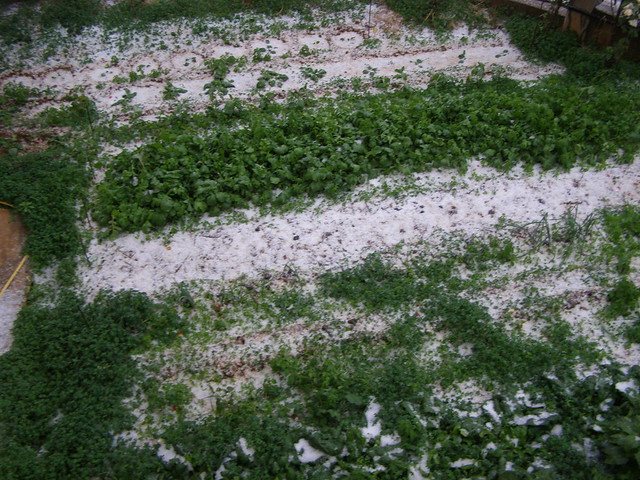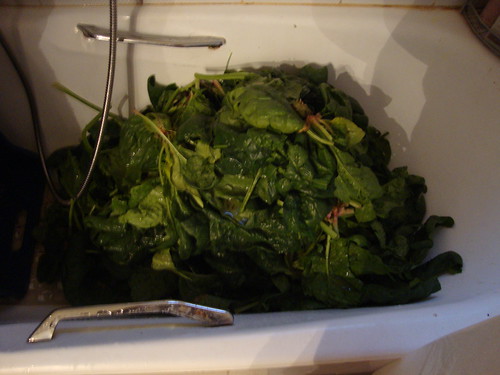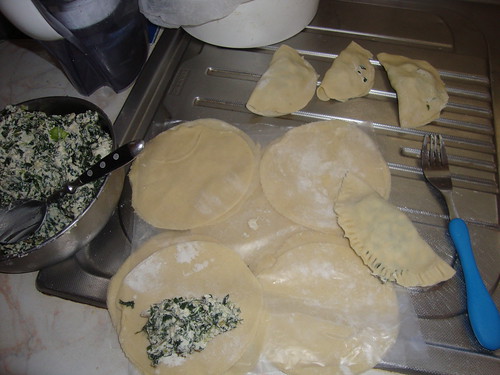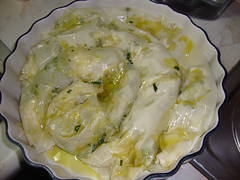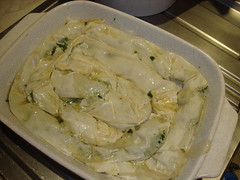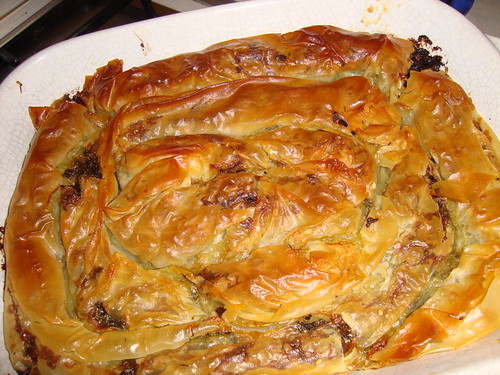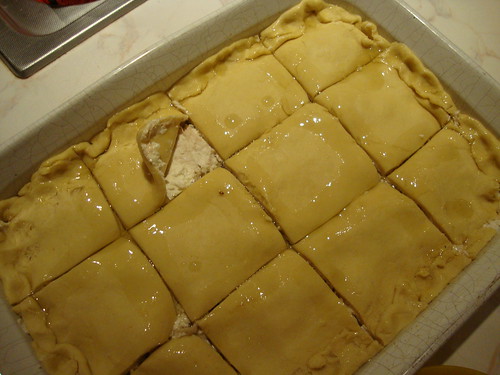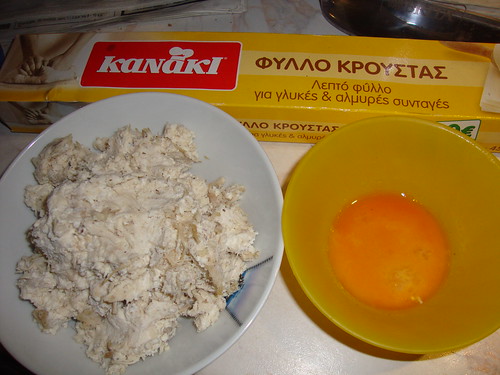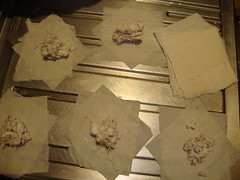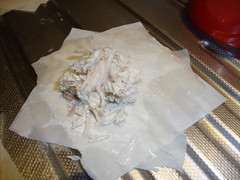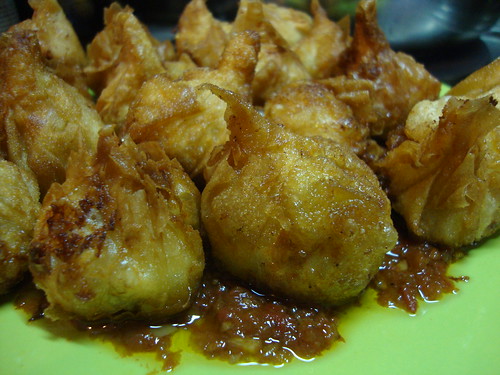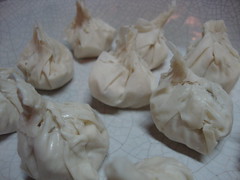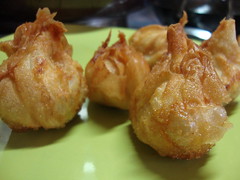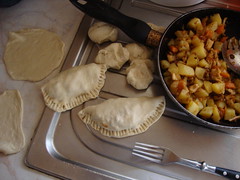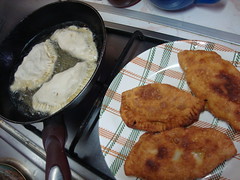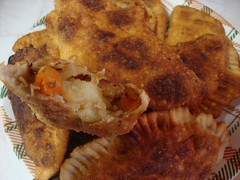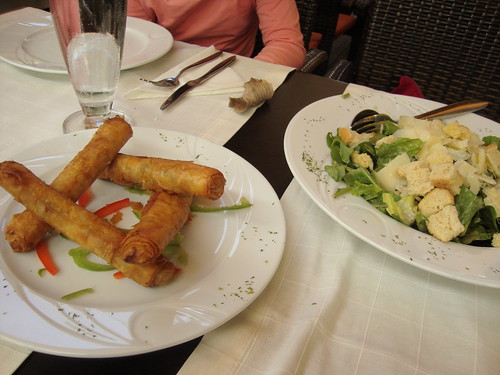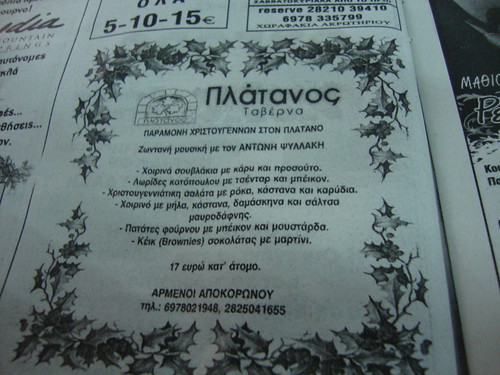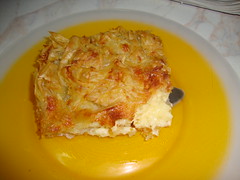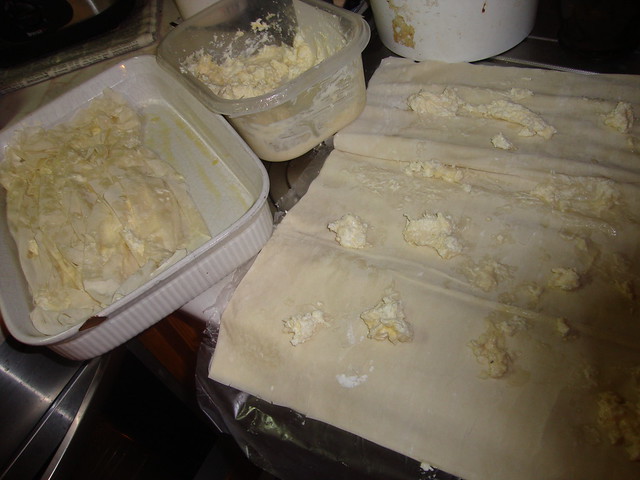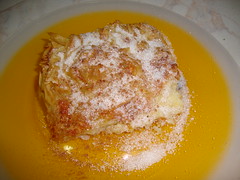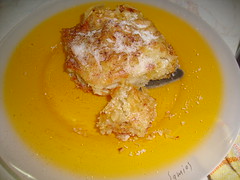Upon hearing the word στιφάδο (stifado), Greek people generally conjure up an image in their mind of a rich red stew of hare or rabbit, chicken, beef or pork, cooked with a large quantity of onions. It constitutes staple winter fare in most parts of Greece, replacing the Sunday roast during the colder months of the year. But with the rising interest in healthy food and a move away from meat, many people nowadays crave a vegetarian version of the same kind of dish. The creative chef at MAICh, Yiani Apostolaki, has once again used his love and knowledge of Cretan cuisine to create a meatless stifado, which has many variations, and can only be termed a masterpiece. Yiani's chestnut stifado is often on the menu during the chestnut season at MAICh, where it is enjoyed by the resident students and staff of the institute.
After having this for lunch at work one day, I decided that I had to make it at home as soon as I could for the whole family to enjoy. My own version of chestnut stifado reflects my family's preferences in spice tastes.
You need:
a few tablespoons of olive oil
1 large onion, chopped finely
2-3 cloves of garlic, chopped finely
500g chestnuts, shelled (to do this, follow the advice in this post; Cretan chestnuts peel easily - not so those from other regions, as I have discovered, when I wanted to buy some bigger and 'better-looking' chestnuts!)
500g whole small stewing onions (large ones don't cook evenly; make a small cross on top of the cleaned onions, as described in this post)
a can of pureed tinned tomatoes (I use my own home-made tomato sauce)
1 teaspoon of tomato paste (for a thicker sauce - this is optional)
1 small wineglass of wine
1 stick of cinammon
6-10 carnation cloves
2 bay leaves
freshly ground pepper
sea salt
In a wide pot, heat the oil and sautee the chopped onion and garlic till translucent. Add the whole onions and mix till they are coated in oil. Add the seasonings and wine, and leave the pot to simmer for a few minutes. Now add the pureed tomatos and tomato paste. If the mixture is too thick, you can add some water to the pot at this stage, but don't add too much: this will depend on the size of the onions. The topmost level of the liquids should be about 1cm below the topmost surface of the onions. Place a lid on the pot, and let the onions simmer at the lowest heat for 30 minutes. Now add the chestnuts, which will have been partly cooked when they were boiled (or roasted) to be cleaned,and cover the pot again. Allow the chestnuts enough time to soften. This depends on the desired texture; if you prefer the nuts to crunchy, then the stew doesn't need a lot of cooking time.
The meat version of this same stew (ie using meat chunks instead of chestnuts) will fill you up very quickly. But the vegetarian versions are so much lighter, that you will find yourself eating more than one serving, or a very large one at that, and you won't have that bloated stuffed feeling that eating such a rich meal usually gives!
Not only that, but the same technique, sauce and spices can also be used in vegetarian stifado using other ingredients; any firm vegetables will work, eg carrots, potatoes, eggplant, mushrooms and pumpkin (which Yiani also adds to his chestnut stifado), as long as they can retain their shape while cooking. Such vegetables have the same fullness as meat, while being exclusively vegetarian products. The tomato-based sauce hints at the taste of umami, a taste inherent in meat that people often crave, even when they are vegetarians, thus satisfying their tastebuds. Only the cooking times for each vegetable will change, according to the desired texture of the finished dish.
The traditional way to serve stifado in Greece is with fried potatoes or thick pasta, but any carbohydrate will do. I served mine with pilafi rice made with a very light chicken stock. Using aromatic basmati rice provides even more umami taste, if you want to keep the meal completely vegan. This dish also needs a very fresh green salad to accompany it, and very little else.
UPDATE 8-12-2011: Due to the recent popularity of this post, here are two variations of chestnut stew: one uses potatoes (served at a mountain village food festival) and the other with mushrooms (served in a popular restaurant in Hania).


©All Rights Reserved/Organically cooked. No part of this blog may be reproduced and/or copied by any means without prior consent from Maria Verivaki.
After having this for lunch at work one day, I decided that I had to make it at home as soon as I could for the whole family to enjoy. My own version of chestnut stifado reflects my family's preferences in spice tastes.
You need:
a few tablespoons of olive oil
1 large onion, chopped finely
2-3 cloves of garlic, chopped finely
500g chestnuts, shelled (to do this, follow the advice in this post; Cretan chestnuts peel easily - not so those from other regions, as I have discovered, when I wanted to buy some bigger and 'better-looking' chestnuts!)
500g whole small stewing onions (large ones don't cook evenly; make a small cross on top of the cleaned onions, as described in this post)
a can of pureed tinned tomatoes (I use my own home-made tomato sauce)
1 teaspoon of tomato paste (for a thicker sauce - this is optional)
1 small wineglass of wine
1 stick of cinammon
6-10 carnation cloves
2 bay leaves
freshly ground pepper
sea salt
In a wide pot, heat the oil and sautee the chopped onion and garlic till translucent. Add the whole onions and mix till they are coated in oil. Add the seasonings and wine, and leave the pot to simmer for a few minutes. Now add the pureed tomatos and tomato paste. If the mixture is too thick, you can add some water to the pot at this stage, but don't add too much: this will depend on the size of the onions. The topmost level of the liquids should be about 1cm below the topmost surface of the onions. Place a lid on the pot, and let the onions simmer at the lowest heat for 30 minutes. Now add the chestnuts, which will have been partly cooked when they were boiled (or roasted) to be cleaned,and cover the pot again. Allow the chestnuts enough time to soften. This depends on the desired texture; if you prefer the nuts to crunchy, then the stew doesn't need a lot of cooking time.
The meat version of this same stew (ie using meat chunks instead of chestnuts) will fill you up very quickly. But the vegetarian versions are so much lighter, that you will find yourself eating more than one serving, or a very large one at that, and you won't have that bloated stuffed feeling that eating such a rich meal usually gives!
Not only that, but the same technique, sauce and spices can also be used in vegetarian stifado using other ingredients; any firm vegetables will work, eg carrots, potatoes, eggplant, mushrooms and pumpkin (which Yiani also adds to his chestnut stifado), as long as they can retain their shape while cooking. Such vegetables have the same fullness as meat, while being exclusively vegetarian products. The tomato-based sauce hints at the taste of umami, a taste inherent in meat that people often crave, even when they are vegetarians, thus satisfying their tastebuds. Only the cooking times for each vegetable will change, according to the desired texture of the finished dish.
The traditional way to serve stifado in Greece is with fried potatoes or thick pasta, but any carbohydrate will do. I served mine with pilafi rice made with a very light chicken stock. Using aromatic basmati rice provides even more umami taste, if you want to keep the meal completely vegan. This dish also needs a very fresh green salad to accompany it, and very little else.
UPDATE 8-12-2011: Due to the recent popularity of this post, here are two variations of chestnut stew: one uses potatoes (served at a mountain village food festival) and the other with mushrooms (served in a popular restaurant in Hania).

©All Rights Reserved/Organically cooked. No part of this blog may be reproduced and/or copied by any means without prior consent from Maria Verivaki.
